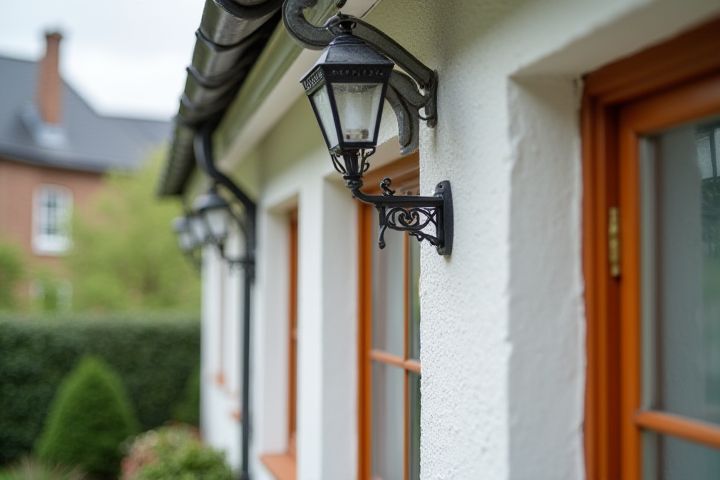
Regular maintenance of your house exterior enhances curb appeal and protects your investment. Start by inspecting and cleaning your gutters to prevent water damage and ensure proper drainage. Paint or stain wooden surfaces every few years to safeguard against rot and weather wear. Check roofing materials for missing shingles or leaks, as timely repairs can extend the lifespan of your roof. Finally, power wash siding and walkways to remove dirt and mold, keeping your home looking fresh and inviting.
How To Maintain A House Exterior
Regularly clean gutters.
Regularly cleaning your gutters is essential for maintaining the exterior of your house, preventing water damage to your roof and foundation. Clogged gutters can lead to significant issues such as mold growth, leaks, or even structural damage, which can cost hundreds to thousands of dollars in repairs. It's recommended to clean your gutters at least twice a year, ideally in the spring and fall, to ensure they remain clear of debris. Investing in a quality pair of gloves and a sturdy ladder can make this task safer and more efficient, ultimately protecting your home's value and longevity.
Inspect and repair roof shingles.
Inspect your roof shingles at least twice a year, ideally in spring and fall, looking for signs of wear such as curling, missing shingles, or discoloration. If you find any damaged shingles, replace them immediately to prevent leaks, as even a small gap can lead to significant water damage, costing you hundreds or thousands in repairs. Regularly clean your roof of debris like leaves and moss, which can trap moisture and accelerate shingle deterioration. Consider a professional inspection every three to five years if your roof is over 20 years old, ensuring it remains structurally sound and protecting your home's overall integrity.
Pressure wash siding and walkways.
To maintain a clean house exterior, pressure washing is crucial for both siding and walkways. Regularly using a pressure washer removes dirt, grime, and mold, enhancing your home's curb appeal and preventing long-term damage. Focus on the siding, ensuring you use the correct pressure settings to avoid damaging the material, and use a cleaning solution designed for exterior surfaces. For walkways, the process eliminates slippery algae and stains, ensuring a safe environment while improving the overall aesthetic of your property.
Repaint or seal exterior surfaces.
To maintain your house's exterior, prioritize repainting or sealing surfaces to protect against weather damage and enhance curb appeal. Regularly inspect areas like wood siding, trim, and decks for signs of wear, cracking, or fading, and repaint or reseal as needed to extend their lifespan. Choosing high-quality, weather-resistant paint or sealant can prevent moisture intrusion, mold growth, and deterioration. Establish a maintenance schedule to ensure your home's exterior remains in optimal condition, safeguarding your investment and improving overall aesthetics.
Trim trees and shrubs near the house.
Maintain your house exterior by regularly trimming trees and shrubs within a 3 to 5-foot radius of the foundation. This distance helps prevent moisture buildup that can lead to mold and pest infestations. Use pruning shears to trim branches and foliage that touch or overhang your roof to ensure a clear line of sight for gutters and eaves. Keep in mind that seasonal pruning, ideally late winter or early spring, promotes healthy growth and keeps your landscape tidy.
Check for and seal entry points for pests.
Inspect the exterior of your house for small cracks, gaps, or holes that could serve as entry points for pests like rodents and insects. Pay particular attention to areas around windows, doors, and vents, as well as foundations and siding. Use high-quality sealants or caulking to effectively close these openings, ensuring a tight barrier against unwanted intruders. Regular checks every season can help maintain your home's structural integrity and contribute to a pest-free environment.
Maintain drainage around the foundation.
Proper drainage around your home's foundation is crucial for preserving its structural integrity. Ensure that gutters and downspouts direct water away from the foundation, ideally at least five feet, to prevent soil erosion and water pooling. Regularly inspect the grading of your yard, adjusting the slope to guide water flow away from the foundation. Incorporating French drains or rain gardens can further enhance drainage efficiency, safeguarding your home against water-related damages.
Inspect and repair windows and doors.
Inspecting and repairing windows and doors is crucial for maintaining your home's exterior. Start by checking for any gaps, cracks, or damaged weather stripping, as these can lead to energy loss and potential water intrusion. Ensure that the frames are properly sealed and consider applying a fresh coat of paint or sealant to protect against the elements. Regular maintenance not only enhances your home's curb appeal but also extends the lifespan of these essential elements, improving energy efficiency and security.
Clean and repair outdoor lighting.
Regularly inspect your outdoor lighting fixtures for any signs of wear, damage, or dirt buildup, as these can significantly affect illumination efficacy and curb appeal. Replace burnt-out bulbs promptly with energy-efficient options, such as LED lights, to enhance brightness and reduce energy costs. Clean glass surfaces and fixtures using a mild soap solution to eliminate grime, ensuring optimal light output and a polished appearance. Finally, check wiring and connections for safety, making repairs or replacements as needed to keep your outdoor lighting functional and aesthetically pleasing.
Test and service exterior HVAC units.
Regular testing and servicing of exterior HVAC units is crucial for optimal performance and energy efficiency. Schedule professional inspections at least once a year, ideally before the summer and winter seasons, to ensure all components are functioning correctly. Clean or replace air filters every 1-3 months to enhance airflow and prolong system lifespan. Lastly, clear any debris or vegetation around the unit to maintain proper airflow and prevent potential overheating.
